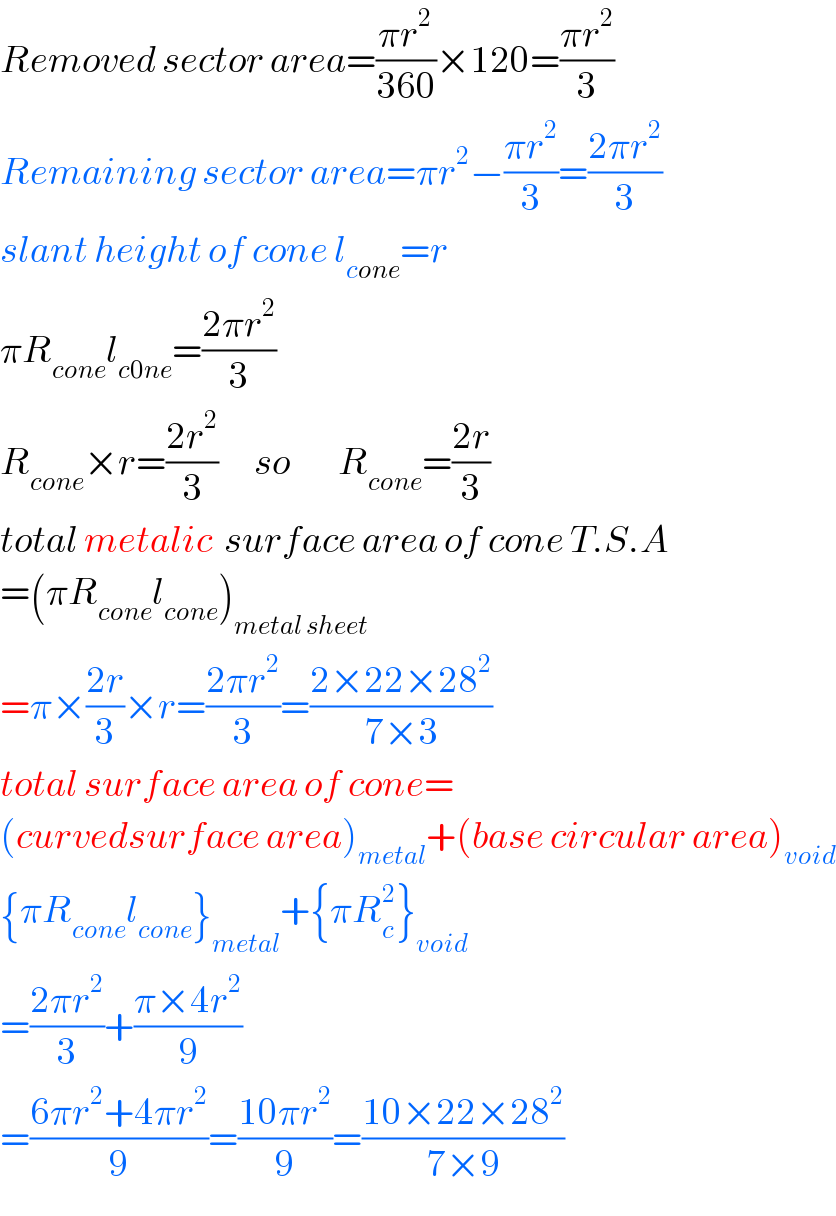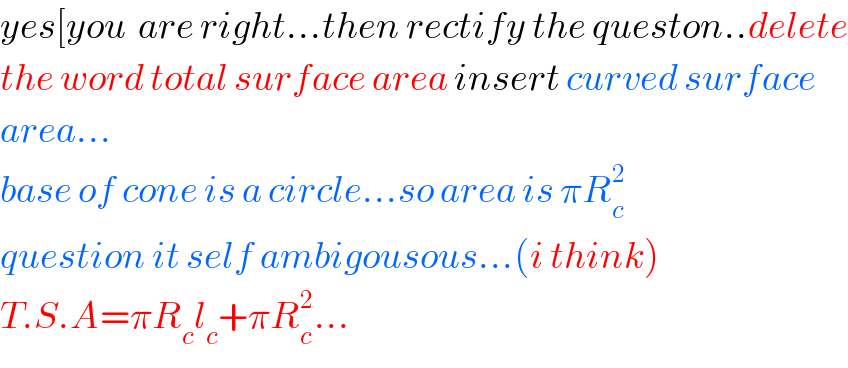Question Number 53867 by byaw last updated on 26/Jan/19

Answered by tanmay.chaudhury50@gmail.com last updated on 27/Jan/19

$${Removed}\:{sector}\:{area}=\frac{\pi{r}^{\mathrm{2}} }{\mathrm{360}}×\mathrm{120}=\frac{\pi{r}^{\mathrm{2}} }{\mathrm{3}} \\ $$$${Remaining}\:{sector}\:{area}=\pi{r}^{\mathrm{2}} −\frac{\pi{r}^{\mathrm{2}} }{\mathrm{3}}=\frac{\mathrm{2}\pi{r}^{\mathrm{2}} }{\mathrm{3}} \\ $$$${slant}\:{height}\:{of}\:{cone}\:{l}_{{cone}} ={r} \\ $$$$\pi{R}_{{cone}} {l}_{{c}\mathrm{0}{ne}} =\frac{\mathrm{2}\pi{r}^{\mathrm{2}} }{\mathrm{3}} \\ $$$${R}_{{cone}} ×{r}=\frac{\mathrm{2}{r}^{\mathrm{2}} }{\mathrm{3}}\:\:\:\:\:\:{so}\:\:\:\:\:\:\:\:{R}_{{cone}} =\frac{\mathrm{2}{r}}{\mathrm{3}} \\ $$$${total}\:{metalic}\:\:{surface}\:{area}\:{of}\:{cone}\:{T}.{S}.{A} \\ $$$$=\left(\pi{R}_{{cone}} {l}_{{cone}} \right)_{{metal}\:{sheet}} \\ $$$$=\pi×\frac{\mathrm{2}{r}}{\mathrm{3}}×{r}=\frac{\mathrm{2}\pi{r}^{\mathrm{2}} }{\mathrm{3}}=\frac{\mathrm{2}×\mathrm{22}×\mathrm{28}^{\mathrm{2}} }{\mathrm{7}×\mathrm{3}} \\ $$$${total}\:{surface}\:{area}\:{of}\:{cone}= \\ $$$$\left({curvedsurface}\:{area}\right)_{{metal}} +\left({base}\:{circular}\:{area}\right)_{{void}} \\ $$$$\left\{\pi{R}_{{cone}} {l}_{{cone}} \right\}_{{metal}} +\left\{\pi{R}_{{c}} ^{\mathrm{2}} \right\}_{{void}} \\ $$$$=\frac{\mathrm{2}\pi{r}^{\mathrm{2}} }{\mathrm{3}}+\frac{\pi×\mathrm{4}{r}^{\mathrm{2}} }{\mathrm{9}} \\ $$$$=\frac{\mathrm{6}\pi{r}^{\mathrm{2}} +\mathrm{4}\pi{r}^{\mathrm{2}} }{\mathrm{9}}=\frac{\mathrm{10}\pi{r}^{\mathrm{2}} }{\mathrm{9}}=\frac{\mathrm{10}×\mathrm{22}×\mathrm{28}^{\mathrm{2}} }{\mathrm{7}×\mathrm{9}} \\ $$
Commented by byaw last updated on 27/Jan/19

$${please}\:{Dear}\:{does}\:{the}\:{metalic}\:{cone} \\ $$$${have}\:{base}\:{area}?\:{Is}\:{it}\:{open}\:{base}\:{or}\:{close}\:{base}? \\ $$
Commented by tanmay.chaudhury50@gmail.com last updated on 27/Jan/19

$${yes}\left[{you}\:\:{are}\:{right}…{then}\:{rectify}\:{the}\:{queston}..{delete}\right. \\ $$$${the}\:{word}\:{total}\:{surface}\:{area}\:{insert}\:{curved}\:{surface} \\ $$$${area}… \\ $$$${base}\:{of}\:{cone}\:{is}\:{a}\:{circle}…{so}\:{area}\:{is}\:\pi{R}_{{c}} ^{\mathrm{2}} \\ $$$${question}\:{it}\:{self}\:{ambigousous}…\left({i}\:{think}\right) \\ $$$${T}.{S}.{A}=\pi{R}_{{c}} {l}_{{c}} +\pi{R}_{{c}} ^{\mathrm{2}} … \\ $$
Commented by byaw last updated on 27/Jan/19

$${It}\:{is}\:{a}\:{past}\:{question} \\ $$
